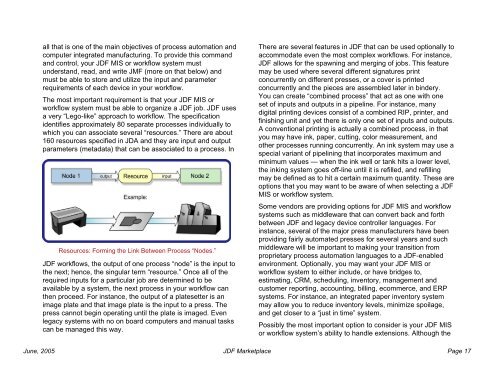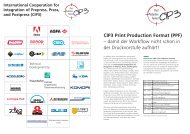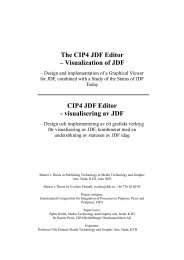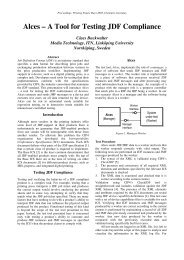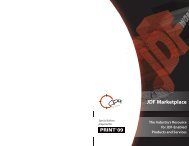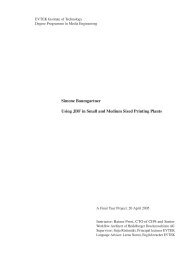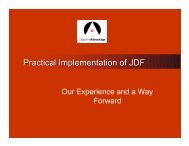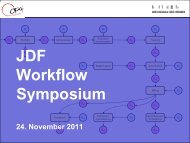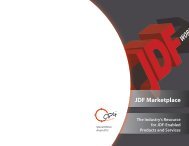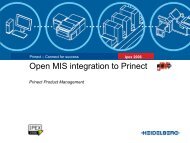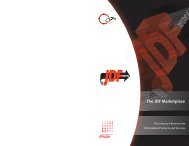The JDF Marketplace - CIP4
The JDF Marketplace - CIP4
The JDF Marketplace - CIP4
- TAGS
- marketplace
- www.cip4.org
Create successful ePaper yourself
Turn your PDF publications into a flip-book with our unique Google optimized e-Paper software.
all that is one of the main objectives of process automation and<br />
computer integrated manufacturing. To provide this command<br />
and control, your <strong>JDF</strong> MIS or workflow system must<br />
understand, read, and write JMF (more on that below) and<br />
must be able to store and utilize the input and parameter<br />
requirements of each device in your workflow.<br />
<strong>The</strong> most important requirement is that your <strong>JDF</strong> MIS or<br />
workflow system must be able to organize a <strong>JDF</strong> job. <strong>JDF</strong> uses<br />
a very “Lego-like” approach to workflow. <strong>The</strong> specification<br />
identifies approximately 80 separate processes individually to<br />
which you can associate several “resources.” <strong>The</strong>re are about<br />
160 resources specified in JDA and they are input and output<br />
parameters (metadata) that can be associated to a process. In<br />
Resources: Forming the Link Between Process “Nodes.”<br />
<strong>JDF</strong> workflows, the output of one process “node” is the input to<br />
the next; hence, the singular term “resource.” Once all of the<br />
required inputs for a particular job are determined to be<br />
available by a system, the next process in your workflow can<br />
then proceed. For instance, the output of a platesetter is an<br />
image plate and that image plate is the input to a press. <strong>The</strong><br />
press cannot begin operating until the plate is imaged. Even<br />
legacy systems with no on board computers and manual tasks<br />
can be managed this way.<br />
<strong>The</strong>re are several features in <strong>JDF</strong> that can be used optionally to<br />
accommodate even the most complex workflows. For instance,<br />
<strong>JDF</strong> allows for the spawning and merging of jobs. This feature<br />
may be used where several different signatures print<br />
concurrently on different presses, or a cover is printed<br />
concurrently and the pieces are assembled later in bindery.<br />
You can create “combined process” that act as one with one<br />
set of inputs and outputs in a pipeline. For instance, many<br />
digital printing devices consist of a combined RIP, printer, and<br />
finishing unit and yet there is only one set of inputs and outputs.<br />
A conventional printing is actually a combined process, in that<br />
you may have ink, paper, cutting, color measurement, and<br />
other processes running concurrently. An ink system may use a<br />
special variant of pipelining that incorporates maximum and<br />
minimum values — when the ink well or tank hits a lower level,<br />
the inking system goes off-line until it is refilled, and refilling<br />
may be defined as to hit a certain maximum quantity. <strong>The</strong>se are<br />
options that you may want to be aware of when selecting a <strong>JDF</strong><br />
MIS or workflow system.<br />
Some vendors are providing options for <strong>JDF</strong> MIS and workflow<br />
systems such as middleware that can convert back and forth<br />
between <strong>JDF</strong> and legacy device controller languages. For<br />
instance, several of the major press manufacturers have been<br />
providing fairly automated presses for several years and such<br />
middleware will be important to making your transition from<br />
proprietary process automation languages to a <strong>JDF</strong>-enabled<br />
environment. Optionally, you may want your <strong>JDF</strong> MIS or<br />
workflow system to either include, or have bridges to,<br />
estimating, CRM, scheduling, inventory, management and<br />
customer reporting, accounting, billing, ecommerce, and ERP<br />
systems. For instance, an integrated paper inventory system<br />
may allow you to reduce inventory levels, minimize spoilage,<br />
and get closer to a “just in time” system.<br />
Possibly the most important option to consider is your <strong>JDF</strong> MIS<br />
or workflow system’s ability to handle extensions. Although the<br />
June, 2005 <strong>JDF</strong> <strong>Marketplace</strong> Page 17


